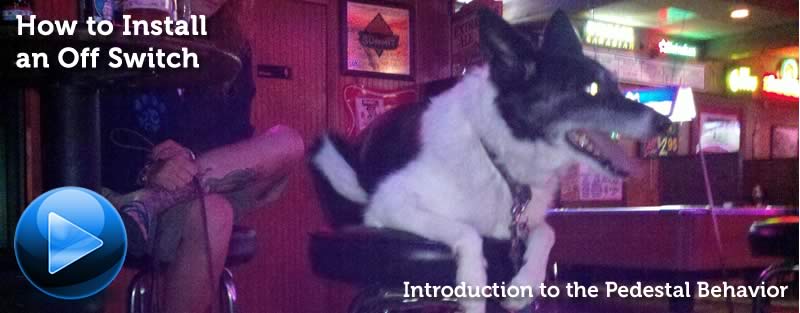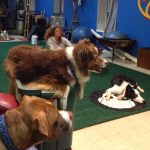
Introduction to the Pedestal Behavior
What is a Pedestal?
Pedestal is a raised spot, essentially a table.
We use all kinds of things as Pedestals – exercise balls, stools, plastic tubs, crates, chairs, stools, boulders, stumps, picnic tables, benches… you name it and if our dog can hop up and stay on there, we’ll use it.
Our favorite Pedestal is an old end table with some carpet on top, as you see in the video above.
The more objects we can generalize this skill to the more readily our dogs will take to different Pedestals. Here’s an example for those of you who play disc with your dogs… A footstall here at Pawsitive Vybe (dog hops up and stays on feet) takes place in just a few moments. We got Prima, one of our Red Dogs, to hop up on my feet and stand on her hind legs in less than 30 seconds. Not bad considering it often takes people months to get that skill…
Why Use a Pedestal?
We like to use Pedestals here at PVybe HQ because it is a very Black and White behavior. The dog is either on it, or not on it, plain and simple. A Spot, while definitely more concrete than simply putting a dog in a Sit or Down, is not nearly as concrete as the Pedestal.
A Pedestal also requires work to get up on, which means that any breaking of the duration behavior will mean no cookies and more work. Not a good combination for operant dogs.
Also, a Pedestal allows the handler to notice, even out of the corner of the eye (perhaps even hear) the dog getting out of position which is valuable for delivering clear consequence to a dog that is not holding position while the handler is engaged with another dog.
How?
The video above lays it out, pretty much, and it’s essentially the same skill as a spot.
We can free shape it (wait for the dog to offer the skill on their own) or we can be a bit more direct and reward for position as illustrated in the video.
It’s probably not a good idea to use a Table cue, for those of you involved in Agility. We’d hate to pollute that perfect performance with new meaning.
Tips
Open Invitation – It’s Yours
When you are rewarding for position, don’t hold the cookie in your fingertips like a lure. Hold the cookie in the palm of your hand or in a fashion that makes it obvious that the dog should take it.
Lots of times when we reward for position onto an object or into a different situation with a cookie that looks like a lure, we wind up triggering some apprehension and the dog might not go after the cookie.
If the hand is open, it’s an open invitation. You’ve earned it, all you have to do is come and get it.
Shaping the Up-Pup
We use a generic cue for getting on top of things, it’s called up-pup. Because we generalize the heck out of this skill and use many objects as Pedestals, we invariably wind up with objects that our dog is not comfy with jumping on top of.
When our dog stands up and puts the front paws on the object we’re wanting them atop of, initially we may reduce our criteria and mark and reinforce this lower expression of the behavior with shoveling cookies then calling the off, just as we would a full 4 feet on.
We get a couple reps of this and then up the ante, using the reward for position concept – stand up and put your front feet on the pedestal Spot is a “go to a place”, or “go to a mat” behavior. This means that the dog seeks out and performs a duration behavior on a spot of the handler’s choosing. A... More – yes! – then place the cookie in an open palm high enough and far enough onto the object so the dog must get 4 feet on if they want the cookie they earned.
Spot is a “go to a place”, or “go to a mat” behavior. This means that the dog seeks out and performs a duration behavior on a spot of the handler’s choosing. A... More – yes! – then place the cookie in an open palm high enough and far enough onto the object so the dog must get 4 feet on if they want the cookie they earned.
If we are consistent in our application of this shaping concept, as soon as the sequence starts – balk at the 4 feet on the Pedestal, reinforce for 2 feet, up the ante – the understanding of the pedestal behavior is triggered.
It doesn’t take long at all for the dog to generalize this skill and to become confident in performing it.







